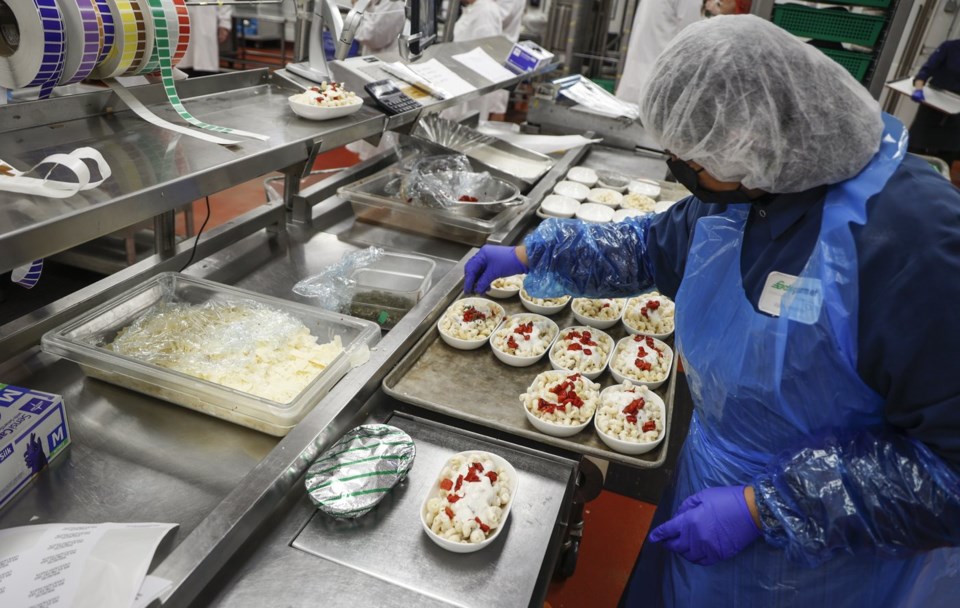CALGARY — Molly Brandt, executive chef for in-flight catering company Gate Gourmet, sees her role as similar to that of a fashion designer creating haute couture.
Her tasting events for airline clients are similar to a runway show, she said, in that she unveils one-of-a-kind menu items that have taken months to develop.
If clients like them, her creations are simplified and modified into "fast fashion" — her term for the final product that lands on the air passenger's tray table.
"The goal here is I'm trying to move this forward and I'm trying to keep it modern and fresh," said Brandt.
"It can be really, really challenging. You truly have to think outside of the box to create something that's very special."
The challenges of providing meals at 30,000 feet were on display Tuesday, when Gate Gourmet gave reporters a tour of its Calgary facility — one of eight the Swiss-owned air catering company operates across the country.
Gate Gourmet counts Air Canada, WestJet and a number of international carriers operating in Canada among its customers. On any given day, the company caters to between 500 and 600 flights, both domestic and overseas.
In Calgary alone, Gate Gourmet produces about 5,000 meals per day, cooking and assembling them on-site and then loading them on trucks for delivery directly to waiting planes.
Like the rest of the aviation industry, Gate Gourmet has only recently emerged from what president and managing director for Canada Tony Colliss described as the "extremely challenging" COVID-19 pandemic.
"Our business probably dropped to about 20 per cent of the normal levels," said Colliss, explaining that when air travel ground to a virtual halt in 2020 Gate Gourmet was forced to lay off the majority of its workforce.
"Even what we were providing on board was very different than what we would normally provide. It was things like packaged snacks and water."
Today, the catering company has returned to its pre-pandemic size, with roughly 2,000 employees across the country.
Earlier this spring, Gate Gourmet workers at Toronto Pearson International Airport were on strike for two weeks, briefly interrupting meal offerings at both Air Canada and WestJet.
The strike ended with a new contract agreement that saw workers receive a 12-per-cent pay increase over three years.
Colliss said Gate Gourmet's business is not automated in any significant way, so taking an airline client's vision for their menu and producing it in a form that can be prepared fresh daily, trucked to a plane and served by flight attendants from a galley kitchen is extremely complex.
"We're constantly having to try and find better ways, or smarter ways, to do the work so that we can hold down our costs for our customers," he said.
While travellers love to hate airline food, Brandt said a great deal of thought and effort goes into in-flight food and beverage options.
Some airlines, she added, seek to differentiate themselves from the competition with the quality of their menu offering — particularly when it comes to luring the coveted business traveler.
The challenge is coming up with exciting and tasty menu items while working within the natural constraints of air travel.
For example, the limited galley space on a plane is needed for heating entrees, which means that any appetizer served on a plane must be cold. Raw fish and rare steak aren't allowed because of food safety precautions. Sharp knives haven't been permitted since the terror attacks of Sept. 11, 2001.
What tends to work best, given dry airplane cabin air, are foods with a lot of natural water content — such as tomatoes, cucumbers and mushrooms. Anything that is slow-cooked in a lot of moisture, such as a stew or a curry, tends to hold up well in the air, Brandt said.
She added these confines make designing airline food items significantly more challenging for a chef than restaurant food.
"I have a very small sandbox that I'm allowed to play within," Brandt said. "I can scoop a little sand out, and scoop a little sand in. But (at) the end of the day, the box is really narrow."
This report by The Canadian Press was first published June 18, 2024.
Amanda Stephenson, The Canadian Press

